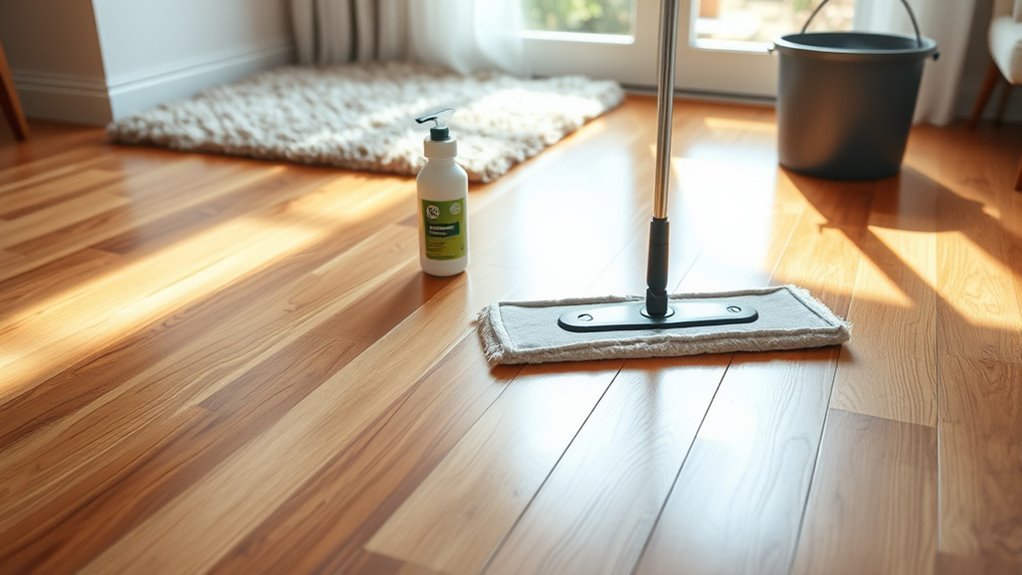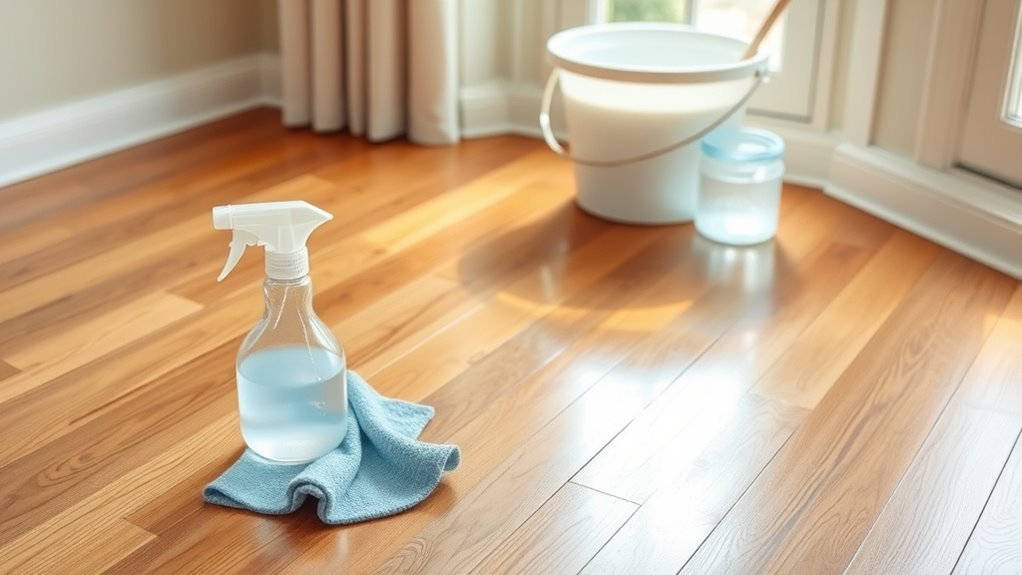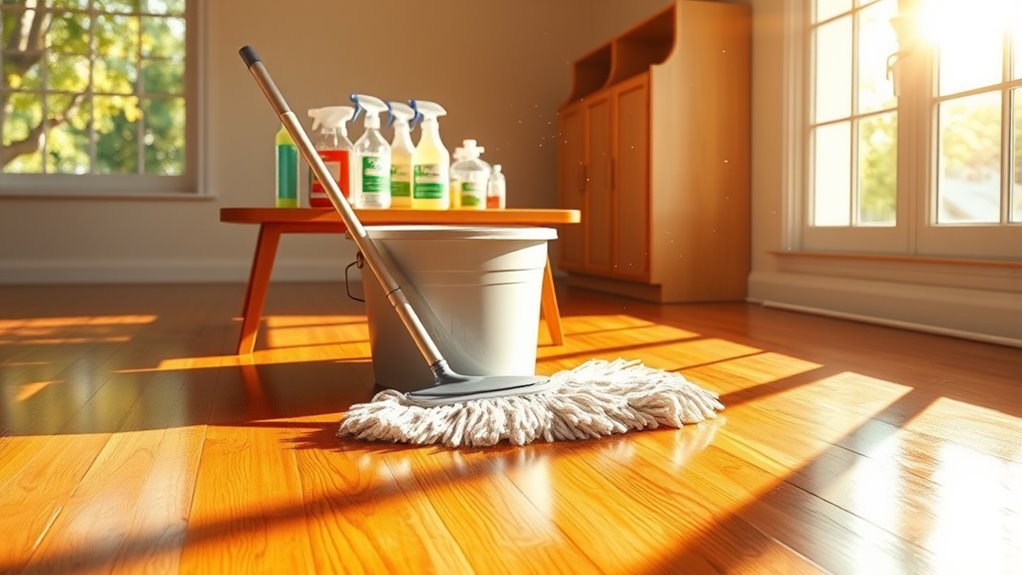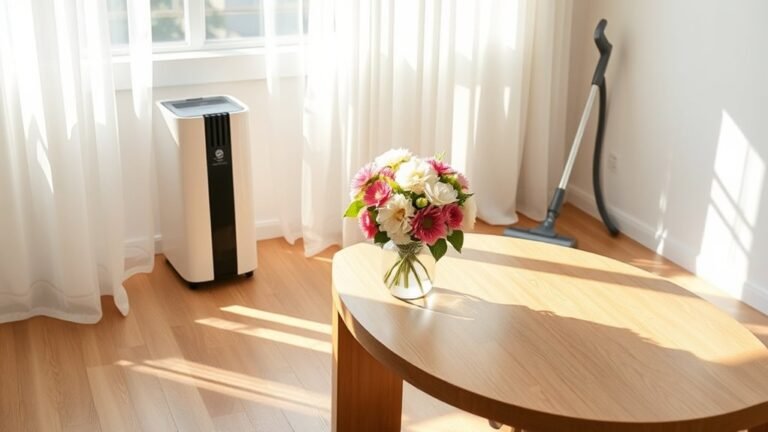Deep Cleaning Guide for Wood Flooring
To deep clean your wood floors, start by removing all furniture and vacuuming thoroughly to clear dust and debris. Use an eco-friendly, gentle cleaner and a damp microfiber mop to protect the wood finish, always mopping with the grain. Dry immediately to avoid water damage. Regular dusting and using quality polish maintain the shine, while gentle stain treatments tackle common marks. Keep following these tips, and you’ll uncover even more ways to keep your floors looking their best.
Preparing Your Wood Floors for Deep Cleaning

Before you plunge into deep cleaning your wood floors, you’ll want to clear the area completely and remove any loose dirt or debris. Start by removing furniture carefully to give yourself full access to the floor. This step not only prevents damage but also frees you to reach every corner and edge. Once the space is clear, grab your vacuum and focus on vacuuming debris thoroughly. Don’t rush this part—getting rid of all particles guarantees your deep cleaning is more effective and your floors stay pristine longer. Taking these preparatory steps lets you move confidently into the cleaning process with no obstacles, giving you the freedom to restore your wood floors to their natural beauty without hassle or interruptions.
Choosing the Right Cleaning Products and Tools
When selecting cleaning products and tools for your wood floors, you’ll want to choose options that protect the finish while effectively removing dirt and grime. Opt for eco friendly cleaners that are free from harsh chemicals, so you can maintain your floors without compromising your health or the environment. These gentle solutions keep your wood looking vibrant and prevent damage over time. Pair them with proper mops designed specifically for wood flooring—microfiber or soft cotton heads work best to avoid scratches. Avoid soaking the floor; instead, use a damp mop to control moisture. By picking the right products and tools, you’re not only preserving your wood floors but also embracing a cleaning routine that aligns with your values of freedom and care.
Step-by-Step Process for Deep Cleaning Wood Floors

Now that you’ve picked the right products and tools, it’s time to tackle the deep cleaning process itself. Start by removing all furniture and debris to clear your workspace. Sweep or vacuum thoroughly to eliminate dust and grit that can scratch your floor. Next, mix your cleaning solution according to instructions, and mop gently, following the wood grain to avoid damage. Don’t oversaturate the floor; use a damp mop, not a soaking one. Once cleaned, dry the floor immediately with a soft cloth or dry mop to prevent water damage. Remember, the right cleaning frequency keeps your floors vibrant and extends their life. Always apply protective measures like felt pads under furniture to maintain your freedom to move without worry.
Tips for Maintaining the Shine After Deep Cleaning
Although deep cleaning gives your wood floors a fresh start, maintaining their shine requires consistent care. To keep that glow, focus on regular shine maintenance by dusting or sweeping daily to prevent grit from dulling the surface. Incorporate polishing techniques like using a quality wood floor polish or a microfiber mop with a specialized polish to revive the luster without buildup. Avoid harsh chemicals that can strip the finish and dull the shine. You might also want to place rugs in high-traffic areas to reduce wear. By sticking to these simple habits, you’ll enjoy your floors’ natural beauty longer and keep your space feeling open and free, without the burden of constant deep cleaning.
Addressing Common Issues and Stains on Wood Flooring

How do you tackle stubborn stains or common issues that pop up on your wood flooring? Start with gentle stain removal methods—dab a soft cloth with a mixture of water and mild soap to lift spills without damaging the finish. For tougher spots, try a wood-specific cleaner to preserve the floor’s natural beauty. When it comes to surface scratches, don’t fret. Use a wood repair marker or a blend of olive oil and vinegar to mask minor imperfections and restore that seamless look. Remember, quick attention keeps issues from worsening, giving you the freedom to enjoy your space without worry. By addressing these concerns promptly and effectively, you maintain your wood floor’s charm and extend its life, freeing yourself from constant upkeep stress.
Häufig gestellte Fragen
Can Deep Cleaning Damage the Finish on Wood Floors?
You might think a deep clean always refreshes your wood floors, but it can sometimes damage the finish if you’re not careful. Using harsh cleaning products without the right protective measures can strip away that beautiful shine you love. To keep your floors looking free and flawless, choose gentle cleaners and test them first. Taking these steps means you’ll enjoy both freedom and stunning wood floors without worry.
How Often Should I Deep Clean My Wood Flooring?
You should set a frequency schedule for deep cleaning your wood flooring based on your lifestyle—usually every 3 to 6 months works well. Don’t overdo it, since harsh cleaning products can wear down the finish. Choose gentle, wood-friendly options that let you enjoy your floors without feeling restricted. By balancing the right cleaning products and timing, you keep your space fresh while maintaining the freedom to live and move as you please.
Is It Safe to Use Vinegar on Wood Floors?
You might think vinegar is a miracle cleaner for everything, but when it comes to wood floors, it’s a bit tricky. While vinegar benefits include cutting through grime and disinfecting, its acidity can dull or damage your floor’s finish over time. If you want to keep your wood free and flawless, consider cleaning alternatives like specially formulated wood floor cleaners—they protect your freedom to enjoy beautiful floors without worry.
Can I Use a Steam Cleaner on Wood Floors?
You might be tempted to use a steam cleaner on wood floors because of its steam cleaner benefits, like quick, chemical-free cleaning. However, you should be cautious since steam cleaner risks include damaging the wood’s finish or causing warping from excess moisture. If you want to keep your floors looking great and maintain your freedom to enjoy them, it’s best to avoid steam cleaners or use them only on sealed, durable wood floors with care.
What Are the Best Humidity Levels for Wood Flooring?
Think of your wood floors like a sailboat—too much water weight, and it swells; too dry, and it cracks. You’ll want to keep humidity control between 35% and 55% to guarantee wood preservation. This balance lets your floors breathe freely without warping or shrinking. By maintaining this sweet spot, your floors stay strong and beautiful, giving you the freedom to enjoy your space without worry.






